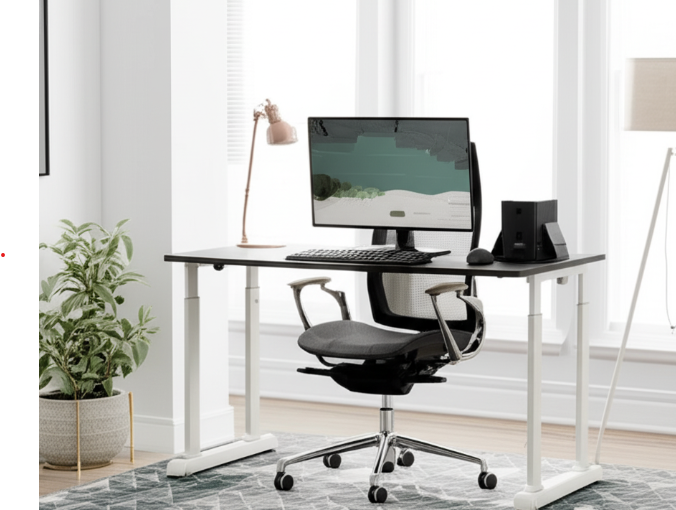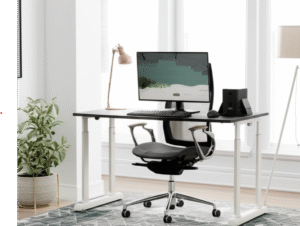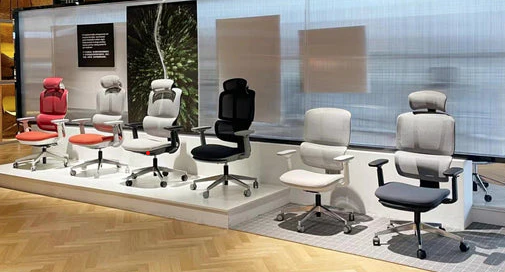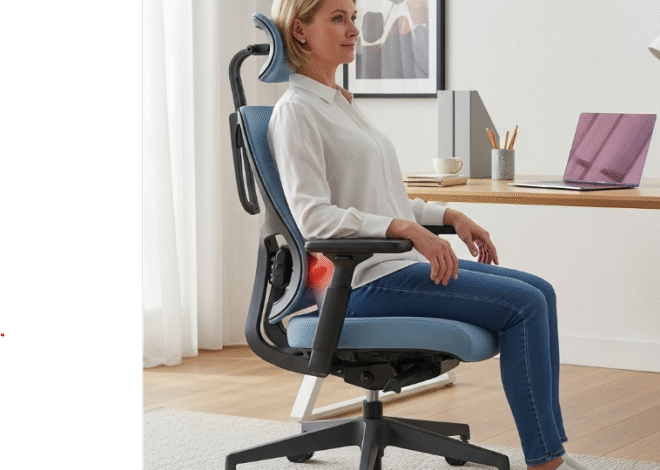
Your Guide to the Best Ergonomic Chair
🧘♀️ Sit Smarter, Feel Better: Your Guide to the Best Ergonomic Chair 🚀
Do you find yourself constantly shifting in your seat, battling an aching back, or experiencing persistent neck stiffness after a long day at your desk? 😩 If so, it might not be your work that’s the problem, but your chair! Investing in the best ergonomic chair isn’t just a luxury; it’s a necessity for anyone who spends significant time seated, whether for work, study, or even hobbies. A poorly designed chair can wreak havoc on your body, leading to discomfort, reduced productivity, and serious long-term health issues.
This comprehensive guide will show you why an ergonomic chair is a game-changer for your health and well-being. We’ll break down the essential features that define the best ergonomic chair, explore different types, and walk you through the process of choosing the perfect one to support your unique body and work habits. Let’s make every moment you sit a comfortable and healthy one! 👇

🧐 Why the Best Ergonomic Chair is a Must-Have for Your Health
An ergonomic chair is specifically designed to support your body in a neutral, healthy posture, reducing stress on your spine and joints. Here’s why it’s a crucial investment:
- Pain Relief & Prevention: 🩹 The primary benefit! By conforming to your body’s natural curves and promoting proper alignment, an ergonomic chair significantly reduces the risk of developing or worsening common issues like lower back pain, neck strain, and carpal tunnel syndrome.
- Improved Posture: 🚶♀️ It actively encourages and maintains good posture, preventing slouching and hunching. Over time, this strengthens core muscles and reduces chronic strain.
- Increased Productivity & Focus: 🧠 When you’re comfortable and pain-free, you’re less distracted by discomfort. This allows you to concentrate better, leading to higher efficiency and better quality work.
- Enhanced Blood Circulation: 🩸 Proper design ensures there’s no undue pressure on your legs and thighs, promoting healthy blood flow and preventing numbness or swelling.
- Reduced Fatigue: iredness often comes from your body working harder to compensate for poor support. An ergonomic chair minimizes this effort, helping you stay energized and alert for longer periods.
- Long-Term Health Benefits: Regular use of a well-fitted ergonomic chair can prevent musculoskeletal disorders and contribute to better overall physical health as you age.
- Adaptability to Your Body: 💪 Unlike standard chairs, ergonomic chairs are highly adjustable, meaning you can fine-tune them to fit your specific body dimensions and preferences, rather than forcing your body to adapt to the chair.
🛠️ Key Features That Define the Best Ergonomic Chair
When you’re searching for the best ergonomic chair, you’ll find that adjustability and support are paramount. Here are the non-negotiable features:
1. Extensive Adjustability 🔄
This is the hallmark of an ergonomic chair. The more options you have to fine-tune it to your body, the better:
- Seat Height Adjustment: ⬆️⬇️ Essential for ensuring your feet are flat on the floor (or on a footrest) and your knees are at a comfortable 90-degree angle. This is the most basic yet crucial adjustment.
- Seat Depth Adjustment: 📏 Allows you to slide the seat forward or backward. This is vital to ensure there’s a healthy 2-4 inch gap between the edge of the seat and the back of your knees, preventing pressure on your circulation.
- Lumbar Support (Adjustable): 🧘♀️ This is perhaps the most important feature. It should be adjustable in both height (to align with your lower back’s natural curve) and depth (how far it pushes into your back) to provide precise, personalized support.
- Backrest Recline & Tension: ↩️ Being able to recline and vary your posture is crucial for relieving spinal pressure. Look for a smooth recline mechanism with adjustable tension, allowing you to control how much force is needed to lean back.
- Tilt Lock: 🔒 This feature lets you lock the chair’s recline at various angles, so you can find your perfect working or resting position.
- Armrest Adjustments (Height, Depth, Pivot): ↕️↔️ Well-adjusted armrests reduce strain on your shoulders, neck, and wrists. Look for at least height and depth adjustments. Some premium chairs offer “4D” armrests that also pivot and move sideways. They should allow your arms to rest comfortably at a 90-degree angle to your body.
- Headrest/Neck Support (Adjustable): 💆♀️ For many, especially taller individuals, an adjustable headrest (for height and angle) provides critical support for the neck and upper spine, particularly when reclining.
2. Material & Upholstery 🧵
The choice of material affects comfort, breathability, and durability:
- Mesh: 🌬️ Extremely breathable, making it ideal for warm climates or if you tend to get hot while working. It conforms to your body and distributes weight well.
- Pros: Excellent airflow, lightweight feel.
- Cons: Can be less plush than foam, some lower-quality mesh can stretch over time.
- Fabric: 🧶 Offers good breathability, a soft feel, and a wide range of colors. Generally durable and comfortable for long hours.
- Pros: Comfortable, good friction (prevents sliding), generally robust.
- Cons: Can absorb spills, may be harder to clean than leather/mesh.
- Leather (Genuine or PU): 🐄 Provides a premium, executive look. Genuine leather is highly durable but expensive. PU (Polyurethane) leather is a more affordable synthetic alternative.
- Pros: Luxurious appearance, easy to wipe clean (spills).
- Cons: Less breathable (can cause sweating), PU leather is prone to cracking and peeling over time.
- High-Density Foam: ☁️ Used in the seat pan and sometimes backrest. Look for cold-cured, high-density foam that provides firm, resilient support and won’t flatten out quickly.
3. Build Quality & Durability 💪
An ergonomic chair is an investment in your health, so it should last.
- Frame Material: A robust frame made of steel or aluminum is essential for stability and longevity. Avoid chairs with predominantly plastic frames if you plan to use them heavily.
- Casters (Wheels): ⚙️ High-quality casters glide smoothly across different floor types. Look for durable, universal casters that won’t damage your floors. Rubberized casters are ideal for hard floors.
- Gas Lift: A Class 4 gas lift is the industry standard for safety, durability, and supporting a wide range of user weights.
- Weight Capacity: Always check the chair’s maximum weight rating to ensure it safely supports you. Many brands offer “Big & Tall” versions for larger users.
- Warranty: A generous warranty (5-10+ years) is a strong indicator of the manufacturer’s confidence in their product’s durability and quality.
4. Base Stability vững chắc
A strong, five-point star base (preferably metal) provides essential stability, especially when reclining or moving around your workspace.
🛋️ Types of Ergonomic Chairs: Finding Your Perfect Match
While “ergonomic chair” is a broad term, there are different categories that emphasize specific features or aesthetics:
1. Fully Adjustable Task/Office Chairs 📈 (The Standard Bearers)
- What they are: These are the most common type, designed for prolonged sitting at a desk. They offer extensive adjustments for seat height, depth, lumbar support, armrests, and recline.
- Pros: Maximum customization, superior support for all body types, promotes healthy posture.
- Cons: Can be more expensive due to complex mechanisms.
- Best for: Anyone working 6+ hours a day at a desk, individuals with specific ergonomic needs, or those seeking the highest level of comfort and support.
2. Executive Ergonomic Chairs 🤵 (Style Meets Substance)
- What they are: Often larger, high-back chairs made from premium materials like leather, combining a sophisticated aesthetic with ergonomic features.
- Pros: Luxurious look and feel, good padding, can offer decent ergonomic adjustability (though sometimes less than dedicated task chairs).
- Cons: Often pricier, may prioritize aesthetics over the most refined ergonomic adjustments, can be less breathable if leather.
- Best for: Executive offices, those who prefer a more traditional or luxurious look but still need good support.
3. Mesh Ergonomic Chairs 🌬️ (The Breathable Choice)
- What they are: Chairs primarily constructed with mesh material for the backrest and often the seat.
- Pros: Excellent breathability, prevents sweating, conforms well to the body, often lightweight and modern in design.
- Cons: Some people find mesh less “plush” than padded chairs. Lower quality mesh can sag over time.
- Best for: Warm climates, individuals who tend to get hot, those who prefer a lighter, more modern aesthetic.
4. Drafting Chairs 🎨 (For Higher Work Surfaces)
- What they are: Ergonomic chairs designed for use with standing desks or drafting tables. They feature a taller gas lift and often a foot ring for support.
- Pros: Allows ergonomic seating at higher elevations, good for alternating between sitting and standing.
- Cons: Not suitable for standard desk heights, generally less stable than lower chairs.
- Best for: Artists, architects, standing desk users, lab work, or anyone working at a counter-height surface.
5. Kneeling Chairs 🦵 (Alternative Posture)
- What they are: A unique design that encourages an open hip angle and distributes body weight between your buttocks and shins, reducing pressure on the lower back.
- Pros: Can alleviate lower back pain for some users, encourages active sitting and core engagement.
- Cons: Not suitable for very long periods for everyone, can put pressure on shins, limited mobility, lacks backrest.
- Best for: Short intervals, as a secondary chair, or for specific back conditions (always consult a medical professional before use).
💡 Finding YOUR Best Ergonomic Chair: A Step-by-Step Guide
Choosing the best ergonomic chair is a personal decision that requires careful consideration of your body, work habits, and budget. Here’s how to find your perfect fit:
Step 1: Analyze Your Seating Habits & Physical Needs 🎯
- How many hours do you sit daily? If you’re at your desk for 6+ hours, a high-end, fully adjustable ergonomic chair is highly recommended. For fewer hours, you might not need as many bells and whistles.
- Do you have any pre-existing conditions? (e.g., chronic back pain, sciatica, neck issues, carpal tunnel). If so, prioritize chairs with specific support features (like enhanced lumbar adjustment, adjustable armrests) and consult with a physical therapist for recommendations.
- What’s your body type? Your height, weight, and build are crucial. Check the chair’s specifications for recommended user height and weight capacity. Some brands offer different chair sizes (e.g., small, standard, large) to ensure a proper fit.
- What’s your work style? Do you lean forward, recline often, or fidget? Your chair should support your natural movements.
Step 2: Set a Realistic Budget 💰
Ergonomic chairs vary widely in price. While it might be tempting to opt for a cheaper model, remember that quality ergonomic chairs are an investment in your long-term health and productivity.
- Entry-Level ($150-$300): You can find basic ergonomic features, but adjustability and material quality might be limited. Suitable for occasional use or those on a very strict budget.
- Mid-Range ($300-$700): This is the sweet spot for many. You’ll find a good balance of essential ergonomic adjustments, decent material quality, and reliable durability. Many excellent options fall here.
- High-End ($700+): These are the premium chairs (e.g., Herman Miller, Steelcase, Humanscale). They offer the most extensive adjustability, superior materials, exceptional durability, and long warranties. They are built to last decades and provide unparalleled comfort.
Step 3: Prioritize Key Ergonomic Adjustments ⚙️
Based on your initial assessment, list the non-negotiable adjustments. For most users, adjustable lumbar support, seat height, and armrest height are critical. Seat depth and recline are also highly beneficial.
Step 4: Consider Materials & Aesthetics ✨
Choose materials that suit your preferences for breathability, comfort, and ease of cleaning. Then, think about how the chair will fit into your workspace’s aesthetic. Do you prefer a modern mesh look, a classic leather feel, or a cozy fabric?
Step 5: Read In-Depth Reviews & Compare Models 💬
- Credible Sources: Look for reviews from reputable office furniture reviewers, ergonomic experts, and well-known tech/lifestyle publications (e.g., Wirecutter, RTINGS, Ergonomic Trends).
- User Experiences: Pay close attention to what actual users say about long-term comfort, specific adjustments, durability, and any common issues after prolonged use.
- Specification Comparison: Create a simple chart to compare the features, dimensions (especially seat height/depth range), weight capacity, and warranty of your top contenders.
Step 6: Test Drive the Chair (If Possible!) 🧑🔬
This is arguably the most important step. If you can visit a showroom or a store that carries office furniture, sit in the chairs you’re considering. This allows you to:
- Assess Fit: Does it feel right for your body? Can you achieve optimal posture?
- Test Adjustments: How easy are the adjustments to use? Do they provide the range you need?
- Feel the Comfort: How does the padding feel? Is the backrest supportive?
- Move Around: Does the chair feel stable when you recline, swivel, or roll?
Step 7: Check the Warranty & Return Policy 📦
A robust warranty (e.g., 5-12 years for parts and frame) signifies a manufacturer’s confidence in their product. Also, ensure the retailer has a fair return policy, ideally allowing you to try the chair for a few days or weeks to ensure it truly meets your ergonomic needs.
🏆 Top Contenders for the Best Ergonomic Chair (Examples)
While the “best” chair is subjective, certain models consistently receive accolades for their superior ergonomics, build quality, and user satisfaction.
1. Herman Miller Aeron 🌟 (The Icon)
- Why it’s great: Often cited as the gold standard. Its unique PostureFit SL lumbar support and Pellicle mesh provide adaptive support and exceptional breathability. It’s highly adjustable and incredibly durable.
- Best for: Those seeking the absolute best ergonomic experience for long hours, willing to invest in a chair that will last decades. People with chronic back issues often find immense relief.
- Considerations: Very expensive, aesthetic might not appeal to everyone.
2. Steelcase Leap 🚀 (Dynamic Support)
- Why it’s great: Known for its “LiveBack” technology, which flexes and conforms to your spine as you move, offering dynamic support. It boasts extensive adjustability, including highly customizable armrests, and excellent material options.
- Best for: Individuals who move a lot while working, those seeking premium ergonomics with a unique flexible backrest, and users who prioritize robust construction.
- Considerations: High price point, but a worthy investment for its comfort and durability.
3. Humanscale Freedom Chair 🧘♀️ (Intuitive Simplicity)
- Why it’s great: Designed by Niels Diffrient, it’s known for its intuitive, weight-sensitive recline and minimal manual adjustments. It automatically adapts to the user’s weight. Excellent lumbar support and comfortable pivoting backrest.
- Best for: Users who prefer a simpler, more automated ergonomic experience without many levers, and those seeking exceptional comfort and support.
- Considerations: Fewer manual adjustments might not suit those who prefer granular control over every setting.
4. Branch Ergonomic Chair 🌱 (Mid-Range Excellence)
- Why it’s great: Offers an exceptional balance of ergonomic features, quality construction, and affordability. It includes adjustable lumbar support, 3D armrests, and a comfortable seat.
- Best for: Budget-conscious buyers who still want genuine ergonomic benefits for long hours. Ideal for equipping a home office without breaking the bank.
- Considerations: While excellent for its price, it won’t have the ultra-fine-tuned adjustments of premium $1000+ chairs.
5. Sihoo M57 / M90D 💰 (Budget-Friendly Ergonomics)
- Why it’s great: These chairs offer a surprising amount of ergonomic adjustability for their budget price, including adjustable lumbar support, a headrest, and armrests. Good value for money.
- Best for: Students, new remote workers, or those on a strict budget who need more than a basic task chair.
- Considerations: Build quality and material longevity might not match premium brands, and cushioning may flatten faster over many years.
🧑💻 Ergonomics 101: How to Set Up Your Best Ergonomic Chair & Workspace
Even the best ergonomic chair needs to be set up correctly to maximize its benefits. Your entire workstation should be optimized for a healthy posture.
- Chair Height: 📏 Adjust your chair so your feet are flat on the floor (or a footrest), and your knees are at approximately a 90-degree angle. Your forearms should be parallel to the floor, with your wrists straight when typing.
- Monitor Height: 🖥️ The top of your monitor screen should be at or slightly below eye level. This prevents neck strain from looking up or down. If you have multiple monitors, ensure they are also optimally positioned.
- Keyboard & Mouse Placement: 🖱️ Keep your keyboard and mouse close to your body to avoid reaching, which can strain your shoulders and wrists. Use an ergonomic keyboard and mouse if possible.
- Lumbar Support: 🧘♀️ Adjust the lumbar support to fit snugly into the natural inward curve of your lower back. It should feel supportive, gently pushing your lower back forward, helping you maintain an upright posture.
- Armrests: 🤝 Adjust armrests so your arms gently rest on them without shrugging your shoulders. They should support your arms without hindering your movement for typing or mousing.
- Take Breaks! 🚶♀️ Even with the most ergonomic setup, prolonged static sitting is unhealthy. Stand up, stretch, and walk around every 30-60 minutes. Consider incorporating a standing desk for portions of your day.
- Lighting: 💡 Ensure your workspace is well-lit to prevent eye strain. Position your screen to minimize glare from windows or overhead lights.
❓ FAQs About Finding the Best Ergonomic Chair
Here are some frequently asked questions about choosing the best ergonomic chair:
Q1: Is an ergonomic chair really worth the price?
A: Absolutely, especially if you spend many hours sitting. It’s an investment in your health, comfort, and productivity. The cost of an ergonomic chair is often far less than the long-term medical bills or productivity loss from a bad back or neck.
Q2: How is an ergonomic chair different from a regular office chair?
A: A “regular” office chair often has limited adjustability and provides basic comfort. An ergonomic chair is specifically designed with extensive adjustability (lumbar support, seat depth, armrests, recline tension) to mold to your unique body shape, promoting a neutral, healthy posture and reducing musculoskeletal strain.
Q3: Can a gaming chair be ergonomic?
A: Some higher-end gaming chairs (like Secretlab, Razer Iskur) incorporate advanced ergonomic features and can be very good. However, many basic “racing-style” gaming chairs prioritize aesthetics over true ergonomics. A dedicated ergonomic office chair is often superior for posture and long-term health if you primarily use it for work.
Q4: How long should I expect the best ergonomic chair to last?
A: It depends heavily on quality. A budget ergonomic chair might last 2-5 years. A good mid-range chair can last 5-10 years. Premium, high-end ergonomic chairs (like Herman Miller, Steelcase) are built with exceptional durability and often come with 10-12+ year warranties, designed to last well over a decade.
Q5: What if I’m tall or heavy?
A: Many ergonomic chair manufacturers offer “Big & Tall” or “XL” versions of their popular models. Always check the chair’s specific height and weight capacity recommendations. Proper fit is crucial for ergonomic benefits.
Q6: Can a cushion make my existing chair ergonomic?
A: A cushion can provide temporary relief or target specific pressure points, but it cannot fundamentally correct the design flaws of a non-ergonomic chair. It’s a band-aid solution; a proper ergonomic chair provides comprehensive support and adjustability.
🏁 Conclusion: Your Body Deserves the Best Ergonomic Chair!
Choosing the best ergonomic chair is one of the most impactful decisions you can make for your health, comfort, and efficiency in any seated activity. It’s not just about comfort; it’s about safeguarding your spine, improving your posture, and empowering you to perform at your best without the distraction of pain.
By understanding the essential features, exploring the different types, and following our step-by-step guide, you’re now equipped to find the perfect ergonomic companion. Invest in your well-being, sit smarter, and feel the difference a truly great chair can make. Your back (and your productivity!) will thank you! ✨🚀


